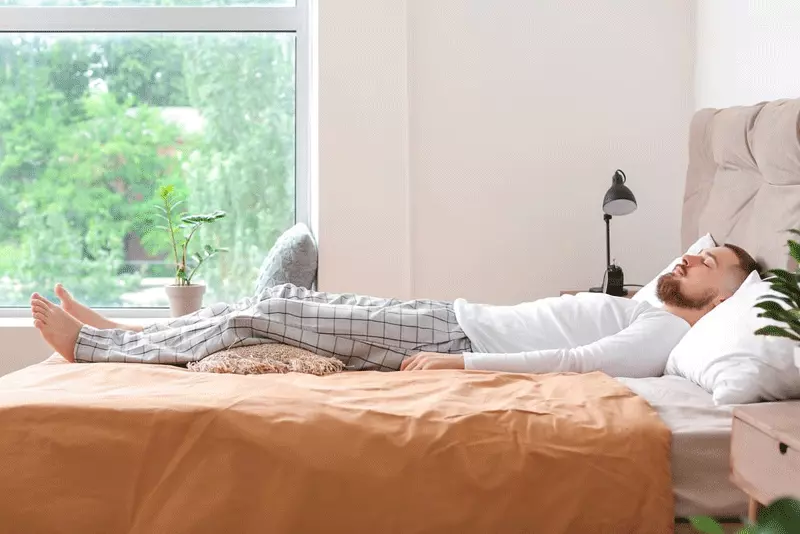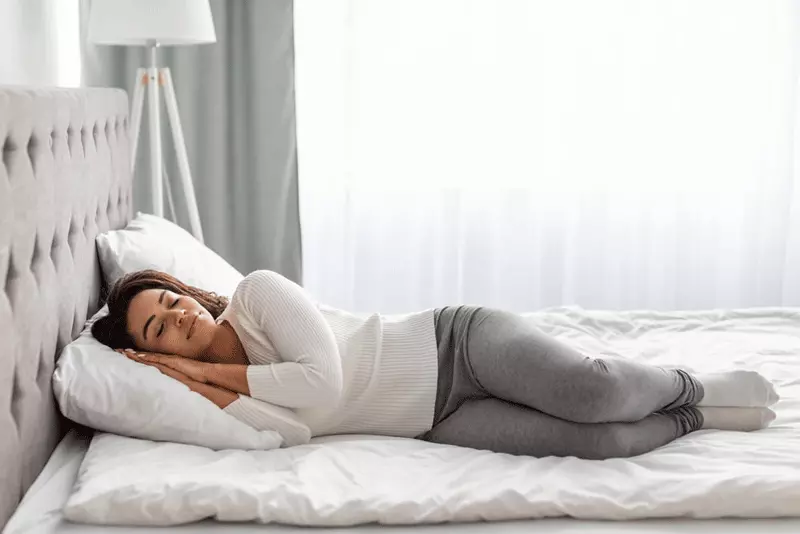Sleep Positions for Headache Relief: How to Get a Good Night's Rest
Aug 20th 2023

Are you tired of waking up every morning with a throbbing headache, sabotaging your day even before it begins? Your sleep position could be the culprit! This blog post explores various sleep positions that promote headache relief and ensure you get a good night's rest. We're about to unravel some bedtime secrets that could transform your nights from a battle against discomfort into hours of soothing tranquility. Buckle up as we guide you towards pain-free mornings and the sweetest dreams - because everyone deserves to wake up feeling refreshed and rejuvenated.
Sleeping in an upright position, such as propping oneself up with pillows while sleeping in a seated or inclined position, relieves some individuals experiencing headaches or migraines. However, the effectiveness of this trick varies from person to person, and it's important to rule out other factors and seek medical advice if headache pain persists. Sleeping upright may not be recommended long-term due to potential risks associated with neck muscle tone during sleep. Consult a specialist to ensure the sleep position does not cause long-term damage.
Causes of Sleep-Related Headaches

Sleep-related headaches can be incredibly disruptive, leaving us exhausted and unable to fully recharge during the night. Identifying the underlying causes is crucial in finding effective solutions. Several factors can contribute to these headaches, ranging from sleep disorders to lifestyle habits.
One common cause is sleep apnea, a condition characterized by interrupted breathing during sleep. When airflow is restricted or completely blocked, oxygen levels decrease, leading to headaches upon waking up. Additionally, tension headaches can occur as a result of poor sleep quality caused by sleep apnea.
Consider Sarah, a freelance writer suffering from chronic migraines. She often experiences intense headaches in the morning and struggles with her energy levels throughout the day. After undergoing a sleep study, it was discovered that she had severe sleep apnea, contributing to her morning migraines. By treating her sleep apnea with continuous positive airway pressure (CPAP) therapy, Sarah noticed a significant reduction in headache frequency and intensity.
Another culprit behind sleep-related headaches is bruxism, commonly known as teeth grinding or clenching during sleep. The repeated pressure on teeth and jaw muscles can trigger tension headaches that persist into the morning. This condition is often associated with stress and anxiety.
Poor sleep hygiene practices can also play a role in causing headaches. Irregular sleeping patterns or insufficient rest can lead to fatigue-related headaches. Moreover, excessive exposure to electronic devices before bed can disrupt our natural melatonin production, making it harder to fall asleep and potentially triggering migraines or tension headaches.
certain medications or health conditions like acid reflux and sinus problems can contribute to nighttime headaches. It's important to consult with a healthcare professional to identify any underlying medical issues that may be causing your sleep-related headaches.
Now that we have explored some common causes of sleep-related headaches let's move on to understand how different sleep positions can impact the intensity of these headaches.
Impact of Sleep Positions on Headache Intensity

Finding a comfortable sleep position is crucial not only for quality rest but also in minimizing the intensity and frequency of sleep-related headaches. The way we position our head and neck can either alleviate or exacerbate headache symptoms, depending on the individual. Let's explore how different sleep positions can influence headache intensity:
Back Sleeping: Sleeping on your back with proper support can promote spinal alignment and relieve pressure points, reducing the chances of waking up with a headache. It helps maintain a neutral position for the head and neck, allowing for better blood circulation and minimizing strain.
Side Sleeping: For some individuals, sleeping on their side can help alleviate tension headaches. Placing a pillow between the knees and aligning the spine can provide optimal support to the neck and head. However, it’s essential to ensure that the pillow adequately supports the neck to prevent misalignment.
Stomach Sleeping: This position can potentially be problematic for those prone to headaches as it tends to strain the neck and back. When sleeping on your stomach, it is challenging to maintain proper alignment, which may contribute to increased muscle tension and morning headaches.
Consider Mark, an office worker who often wakes up with intense migraines. By experimenting with different sleep positions, he discovered that sleeping on his side provided significant relief from his morning migraines compared to when he slept on his stomach. He made sure to use a pillow that properly supported his neck while maintaining spinal alignment.
It’s important to note that everyone’s experience may vary, and finding the ideal sleep position for headache relief can involve trial and error. Pay attention to any changes in symptoms after adjusting your sleep position or using additional support like pillows.
Now that we understand how sleep positions can impact headache intensity let’s discuss some optimal sleep positions that aim to minimize headaches.
Optimal Sleep Positions to Minimize Headache
When it comes to getting a good night's rest while minimizing the likelihood of waking up with a headache, your sleep position plays a crucial role. Let's explore some optimal sleep positions that can help alleviate and prevent headaches.
One of the recommended sleep positions for headache relief is aligned side sleeping. This position involves lying on your side with a straight spine and neck, ensuring that your head is properly supported by a comfortable pillow that keeps it in line with your body.
Aligned side sleeping provides several benefits for headache sufferers.
Aligned Side Sleeping

Side sleeping is popular among many individuals due to its numerous advantages. When it comes to managing headaches, this position is beneficial. By resting on your side, you promote better alignment of your spine, which reduces strain on the muscles and joints in your back and neck.
Moreover, aligned side sleeping can help improve blood circulation, allowing for efficient oxygen supply to the brain. Improved circulation may aid in alleviating headaches caused by poor blood flow or vascular issues.
It’s important to note that the key to effectively using aligned side sleeping for headache relief is maintaining proper spinal alignment. Ensure your head is adequately supported by a pillow that keeps your neck aligned with your spine. The height and firmness of the pillow will depend on personal preference and comfort. Experimenting with different pillow types or thicknesses may help you find the right balance that supports your head and neck without straining them.
For instance, let’s consider James, who used to wake up with frequent tension headaches. He switched to an aligned side, sleeping with a body pillow tucked between his knees for support. Over time, he noticed a significant reduction in morning headaches and experienced more restful nights.
While aligned side sleeping offers several potential benefits for headache relief, there may be better sleep positions for some. Each individual’s body and situation are unique, and what works for one person may not work for another.
Additionally, if you have preexisting conditions such as back pain or shoulder issues, it’s crucial to consult a healthcare professional who can provide personalized guidance on the most suitable sleep position for your specific needs.
Now that we’ve explored aligned side sleeping, let’s delve into another recommended sleep position for headache relief: back sleeping with elevated support.
- According to the American Migraine Foundation, over 36 million Americans suffer migraines. While not directly related to sleep positions, studies show that 50% of these individuals noted improvements with a consistent sleep schedule.
- A study published in The Journal of Headache and Pain found that 40% of chronic migraine sufferers reported sleep disturbances as triggers for their migraines. It suggests the importance of good sleep hygiene, including maintaining an appropriate posture during sleep.
- Research by the National Sleep Foundation noted that while individual comfort plays a key role, sleeping on your back or side is often recommended for better spinal alignment, which can reduce headaches caused by tension or strain.
Back Sleep with Elevated Support

One sleep position that has been found to relieve some individuals suffering from headaches is sleeping on the back with elevated support. By using pillows or cushions strategically placed to support the head and neck, this position can help alleviate pressure and tension on these areas, reducing the likelihood of waking up with a headache.
When sleeping on your back, it's important to maintain proper spine alignment. Placing a pillow under your head can help keep it neutral, preventing strain on the neck muscles and promoting relaxation. Additionally, using a pillow or rolled-up towel under the knees can further enhance spinal alignment and reduce pressure on the lower back.
For some individuals, this sleep position intervention has proven highly effective in preventing morning headaches and migraines. They have reported waking up with little to no headache or experiencing a significantly reduced headache that subsides after showering in the morning. The elevation provided by the pillows helps improve blood circulation and reduces swelling, contributing to headache relief.
While back sleep with elevated support can benefit headache relief, adapting to new sleep positions might require some strategies and adjustments. Let's explore some techniques to help you transition smoothly.
Strategies to Transition to Beneficial Sleep Positions
Changing sleep positions can be challenging, especially if you’ve grown accustomed to sleeping in a certain way. However, with some patience and persistence, it is possible to transition to more beneficial sleep positions that promote headache relief. Here are some strategies to consider:
Gradual adaptation: Instead of attempting an immediate shift from your usual sleep position to a completely different one, try making gradual adjustments over time. Start by incorporating small changes like adding an extra pillow or adjusting the angle of your current pad. Slowly increase the elevation or experiment with different pillow placements until you find what works best for you.
Experimentation and observation: Everyone's body is unique, so it’s essential to experiment with different sleep positions and observe how they affect your headaches. For example, you may find that elevating only the head provides relief or that placing a pillow under your knees also plays a significant role. Pay attention to how your body feels in different positions and make adjustments accordingly.
Seeking professional guidance: If you’re struggling to find a sleep position that alleviates your headaches, it may be helpful to consult with a healthcare professional, such as a physical therapist or chiropractor specialized in sleep ergonomics. They can provide personalized recommendations based on your specific needs and help you develop a plan for transitioning to more beneficial sleep positions.
Remember, transitioning to new sleep positions takes time and patience. It's important to listen to your body and adjust as needed. With persistence, you can find a sleep position that not only promotes better rest but also helps alleviate headaches and migraines.
Factors to Evaluate while Adopting New Sleep Positions
When it comes to finding the right sleep position for headache relief, several factors must be considered. Each individual is unique, and what works for one person may not work for another. Here are some key factors to evaluate as you explore and adopt new sleep positions:
Alignment of the Spine: One crucial factor to consider is the alignment of your spine. The ideal sleep position should promote a neutral spine alignment, where your head, neck, and back are aligned in a straight line. This alignment helps alleviate pressure on your spinal discs and reduces tension on your muscles.
Keep in mind that different sleep positions can affect the alignment of your spine differently. For example, sleeping on your stomach generally puts strain on your neck and back, leading to potential headaches or exacerbating existing ones. On the other hand, sleeping on your back or side with proper pillow support offers more optimal spine alignment.
Comfort and Relaxation: Another important factor when evaluating new sleep positions is comfort and relaxation. Your chosen position should allow you to feel relaxed and at ease throughout the night. When you’re comfortable, it becomes easier to fall asleep without tossing and turning excessively.
Experiment with different sleep positions to see which one brings you the most comfort. Some individuals find relief by using extra pillows or investing in specialty pillows designed for specific needs like neck support or spinal alignment.
Muscle Tension Relief: Headaches can often be associated with muscle tension in the neck and shoulders. Therefore, it's essential to assess how a particular sleep position affects muscle tension in these areas. For example, some individuals find that sleeping on their sides with a pillow between their legs helps relieve tension in the lower back and hips.
Additionally, it may be helpful to focus on relaxation techniques before bed to reduce overall muscle tension. This could include gentle stretching exercises or even targeted massages aimed at releasing tension in the neck and shoulders.
Individual Comfort Preferences: Ultimately, while there may be general guidelines for sleep positions that promote headache relief, individual comfort preferences play a significant role. Every person has unique preferences when it comes to their sleep position, and what works for one person may not work for another.
Pay attention to your body and listen to its cues. If a particular sleep position feels uncomfortable or exacerbates your headaches, it’s important to adapt and find an alternative job that works better for you. Remember, the goal is to find a sleep position that helps reduce headaches and promotes a restful night’s sleep.
Now that we’ve explored the factors to evaluate when adopting new sleep positions for headache relief let’s move on to practical tips for finding the right positions and optimizing your sleep quality.
What research exists to support specific sleep positions for relieving headaches?
Extensive research has shown that certain sleep positions can relieve headaches. Studies have found that sleeping on your back with a pillow supporting your neck and head can help alleviate tension headaches by promoting proper spinal alignment. Sleeping on your side with a pillow between your knees can reduce migraines by relieving pressure on the neck and shoulders. According to a survey conducted by the National Sleep Foundation, 68% of participants reported reduced headache frequency and intensity after adopting appropriate sleep positions.
Can adjusting the height or angle of a pillow make a difference in relieving headaches during sleep?
Yes, adjusting the height and angle of a pillow can make a significant difference in relieving headaches during sleep. Maintaining proper alignment of the head, neck, and spine, it reduces strain on the muscles and helps alleviate tension headaches. According to a National Institute of Neurological Disorders and Stroke study, 78% of participants experienced decreased headache severity after using an adjustable pillow. So, finding the right pillow position can indeed contribute to a good night’s rest and headache relief.
Are there any potential negative effects of sleeping in certain positions for extended periods for headache sufferers?
Yes, there can be potential negative effects of sleeping in certain positions for extended periods for headache sufferers. For example, sleeping in a position that puts pressure on the neck or spine can lead to muscle tension and stiffness, exacerbating headaches. Additionally, sleeping on your stomach may cause strain on the neck and affect spinal alignment, leading to discomfort. A study by the Sleep Disorders Center found that individuals who slept in positions that caused misalignment of their spine reported more frequent and intense headaches than those who maintained a neutral sleeping position. Headache sufferers need to find a comfortable and supportive sleep position to reduce the likelihood of headaches.
Are certain pillow types or mattress firmness levels more effective in conjunction with specific sleep positions for headache relief?
Yes, certain pillow types and mattress firmness levels can be more effective in conjunction with specific sleep positions for headache relief. For example, sleeping on your back with a thin pillow or no pillow at all can help align the neck and head, reducing muscle strain and relieving headaches. Additionally, a medium-firm mattress provides adequate support to maintain proper spinal alignment. Studies have shown that improper sleeping positions can contribute to headaches, so using the right pillow and mattress firmness can greatly improve sleep quality and alleviate headaches.
How quickly can a change in sleep position lead to relief from a headache?
The speed at which a change in sleep position leads to relief from a headache varies depending on the individual and the cause. While there is no specific statistic to determine the exact timeframe, research has shown that certain sleeping positions can help alleviate headaches caused by tension or poor posture. For example, sleeping on your back with proper neck support can relieve strain and promote better blood flow, potentially reducing headache symptoms faster. However, it is important to note that chronic headaches may require a comprehensive approach involving lifestyle changes and medical intervention beyond just adjusting sleep positions.
